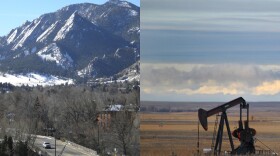Colorado appears poised for strong growth in coming years 鈥� both in terms of the economy and the number of people living here.
According to the most recent forecast from the , more than 7.7 million people will call Colorado home by the year 2040 鈥� an increase of nearly 3 million.
The growth won't happen equally across all regions, though. The Denver-Boulder metro area will see the largest influx of people, with an increase of more than 1 million residents.
Northern Colorado - no stranger to growth in recent years - will likely see its population nearly double from current levels.
The north Front Range, defined geographically as Larimer and Weld counties, could see its population hit 1,054,000 by 2040, says state demographer Elizabeth Garner.
"I will tell you, that will change annually," Garner adds. "We redo our forecast every year to understand, and to be able to take into our forecast, current situations. So there could be something in Larimer-Weld that boosts growth, or there could be something -- for example, a policy change -- that could dampen growth."

There's no doubt that a doubling of the population -- even phased in over several decades -- will take a toll on resources such as water, infrastructure, and land.
Garner thinks Northern Colorado leaders have been fairly proactive in planning for the inevitable. "I think they identified, early on, 'Wow-- we're an attractive area, we're as top places to live,'" she notes.
With tighter budgets and fewer resources to allocate, it's difficult for communities to plan for something so far into the future. But she says, it's important to try to ensure everyone's on board with planning.
"Whether the growth comes today, tomorrow, or ten years from now, let's put the plan in place," she says. "Let's talk about the 'what ifs' in case we have to do it tomorrow."
Interview highlights
With an increase of roughly half a million people expected for Northern Colorado by 2040, is there an epicenter for this growth?
"A lot of the growth that鈥檚 forecast for that region is in Weld, and a lot of it is in southern Weld County. Weld is a very large county, it鈥檚 got a lot of open space, so it鈥檚 got the room for it. Currently prices for land are currently lower than places in the some of the Denver central metro area -- and so that鈥檚 also an attractive piece, being able to purchase a home, buy land, at a price that鈥檚 maybe more affordable."
How much of a role will jobs in the oil and gas industry play?
"Right now, we have increased production in Weld for oil and gas, so our forecast this year I believe is going to be a little bit higher than it was last year.
What鈥檚 interesting is that often, the oil and gas jobs don鈥檛 lead to permanent residents. So often those rigs coming in to do the drilling aren鈥檛 necessarily permanent folks from Weld; they can be off of rigs from different parts of the state, or off rigs from different parts of the U.S. They could work 8 weeks on, 8 weeks off -- and they won鈥檛 necessarily count in our total population."

What about Larimer County? Is the growth primarily going to happen just in Weld?
"No, there鈥檚 going to be growth in Larimer as well. It just has less developable land. A lot of Larimer is mountainous, so you forget that you then hit the mountains and you have Estes Park鈥� that piece of Larimer we don鈥檛 see growing as fast. But it鈥檚 still forecast to grow by [more than] 180,000 people by 2040."
You can create your own charts using from the state demography office website.








